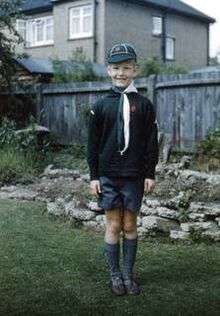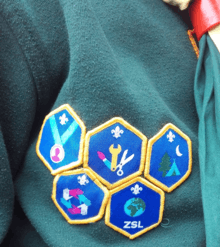Cub Scouts (The Scout Association)
Cub Scouts or Cubs are an age-based section of The Scout Association for young boys and girls ages 8 to 10½. This section follows on from the Beaver Scouts (6-8 year olds) and Cubs will move on to Scouts at the age of 10½. The section originally opened as Wolf Cubs in 1916.
| Cub Scouts | |||
|---|---|---|---|
.svg.png) Cub Scout section logo | |||
| Owner | The Scout Association | ||
| Age range | 8-10½ | ||
| Country | United Kingdom | ||
| Founded | 1916 | ||
| Membership | 153,375 young people (2014)[1] | ||
| |||
History

Early in the development of the Scouting movement, there was a need for provision for those too young to join the Boy Scouts at the age of 11. Robert Baden-Powell published a first draft of a scheme for "Junior Scouts" in 1913, followed by a more detailed outline for "Wolf Cubs or Young Scouts" in January 1914. The finalised programme for 8- to 10-year-old boys was launched at a special conference on 24 June 1916, by which time it had been themed around the Jungle Book written by Baden-Powell's friend and neighbour, Rudyard Kipling; the boys representing the cubs in the Mowgli stories and the leaders being known by the names of the major characters. Each meeting was to start and finish with the "Grand Howl", a ceremony in which the Cubs greeted Akela, the Pack's leader. Baden-Powell also wrote The Wolf Cub's Handbook which was published in December of the same year.[2]
In 1966, as part of a scheme to modernize the whole movement in the United Kingdom, The Chief Scouts' Advance Party Report recommended that the Cub section adopt the same salute as the rest of the association and a similar Promise. The name should change from "Wolf Cubs" to "Cub Scouts" and although the Jungle Book theme should be retained, less emphasis should be placed upon it, especially for older Cubs. A new progressive training scheme of Bronze, Silver and Gold Arrow awards was devised.[3] These proposals were accepted by the association and were implemented between during the year ending October 1967.[4]
_(pre_2003).png)
In February 1990, it was decided in principle that the Association would become fully co-educational, leading to individual Scout Groups being able to decide to accept girls into Cubs and the other sections.[5] A new training scheme for Cub Scouts was launched in September 1990, in which the Arrows were replaced by the Cub Scout Award, the Adventure Award and the Adventure Crest Award.[6]
In May 2000 a new report called 'The Programme Review' was produced after extensive consultation with members of the Association and focus groups. A uniform review was conducted shortly afterwards. The new uniforms were launched in 2001; for Cubs, a redesigned green sweatshirt and navy blue cargo trousers. The implementation of the new training programmes began in 2002.[7]
The total number of Cub Scouts in the UK Scout Association was 153,375 in 2014, up from 150,825 in 2013. The number of girls in the section in 2014 was 24,654.[1]

A series of special events and camps were held in 2016 to celebrate the section's 100th birthday.
Organisation
The Cub Pack forms the middle section of a Scout Group, with the Beaver Colony below and the Scout Troop above. Most Groups will have one Pack, while some others may be able to support two or even more, depending on the number of Cubs within the Group. This is quite rare, as new Groups would be created in areas of large Scouting populations.
Cub Packs have an adult leadership team, which often consists of an appointed Cub Scout Leader (CSL) and Assistant Cub Scout Leaders (ACSLs), and there may also be Section Assistants (also appointed) and often parents or other helpers who help on a semi-regular basis. Although most Packs will have an adult leader appointed as CSL, it is not actually mandatory – thus a Pack may be jointly run by ACSLs only. They can also be supported by Young Leaders. The warranted leaders and Young Leaders are often given names from The Jungle Book - the CSL is normally given the name Akela and popular names for the ACSLs include Baloo, Bagheera, Kaa, Raksha, Chil, Hathi and Rama.
The Cubs within the Pack are separated into Sixes, ideally of five to seven members, with a Sixer and a Seconder (or Second).[8] Also obtainable is the 'rank' of Senior Sixer, who helps the leaders and the Sixes.
Age range
The core age range for cubs is 8 to 10½ years of age, but some flexibility is allowed around this: children may join from 7½ years of age and remain until their 11th birthday.[9]
Awards
Scout Membership Award
The membership award is only received by young people new to Scouting, whereas members who have joined from a Beaver Colony will undertake the Moving-On Award. However, the awards cover the same basic principles and many packs will have all new Cubs participate in the membership award regardless of how they came to join the section.

Challenge awards
There are seven Challenge awards:
- Our Adventure Challenge
- Our Outdoors Challenge
- Our Skills Challenge
- Our World Challenge
- Personal Challenge
- Teamwork Challenge
- Team Leader Challenge.[10]
Each Challenge involves undertaking several tasks or taking part in activities related to a particular type of challenge.[11] Upon completing the seven Challenge awards and six other activity badges, a Cub will have earned the Chief Scout's Silver Award.[12]
The Scout Association recognises that young people might not have completed the Challenge programme by the time they move on to Scouts and so they can continue working towards these awards in their first term as a scout.
Activity badges
Activity badges are awarded for demonstrating skill or achievement in a particular subject which may be an existing hobby or a new area of knowledge. There are currently 34 different badges available.[11] Six other activity badges have different levels or "stages" to recognize levels of achievement on subjects like swimming, music and information technology; these Staged Activity Badges can be gained and worn in all four of the training sections, from Beavers through to Explorers.[13]
Promise and Law
The Cub Scout promise is very similar to the Scout promise, but a few words have been simplified:
I promise that I will do my best,
to do my duty to God and to the Queen,
to help other people
and to keep the Cub Scout Law.
The Cub Scout Law
Cub Scouts always do their best
think of others before themselves
and do a good turn everyday.
Uniform
In 1916, Baden-Powell wanted to make the Wolf Cub uniform totally distinct from the older Boy Scouts; the result was a green woollen jersey, shorts, neckerchief and a green cricket cap with gold piping.[14] Although the 1966 Advanced Party Report brought very little change in the Cub Uniform, following a uniform consultation and review in June 1989, caps were discontinued, a sweatshirt replaced the woollen jersey and black long trousers became an option to shorts.[15]
The current Cub Scout uniform, revised in 2001, consists of a dark green sweatshirt, a neckerchief and woggle, and long navy blue activity trousers. A skirt, activity shorts, a polo shirt a Green logo Baseball Cap and a grey fleece jacket are available as options.[16]
See also
References
- "The Scout Association's Annual Report and Accounts 2013-2014" (PDF). The Scout Association. Retrieved 9 October 2014. (pp. 51-52)
- "The Diamond Jubilee Book of Scouting (pp. 26-27)" (PDF). www.thedump.scoutscan.com. Pearson, London. 1966. Retrieved 24 October 2013.
- "The Advance Party Report '66 (pp. 17-21)" (PDF). www.thedump.scoutscan.com. The Boy Scouts Association. 1966. Retrieved 24 October 2013.
- "Design for Scouting" (PDF). www.thedump.scoutscan.com. The Boy Scouts Association. 1967. Retrieved 24 October 2013.
- An Official History of Scouting, Hamlyn 2006, ISBN 978-0600613985 (p.184)
- Leaders' and Commissioners' Guide to Supporting the Cub Scout Leader with the New Cub Scout Scout Programme. 1990. p. 8. ISBN 978-0-85165-240-5.
- An Official History of Scouting (p.185)
- The Scout Association, Sixers and Seconders, accessed 6 January 2020
- The Scout Association, Age range flexibility, accessed 6 January 2020
- "Member Resources: Challenge Awards". www.scouts.org.uk. The Scout Association. Retrieved 11 January 2018.
- "Member Resources - Cubs - Cub Scout badges and awards". www.scouts.org.uk. The Scout Association. Retrieved 24 October 2013.
- "Chief Scout's Silver Award". www.scouts.org.uk. The Scout Association. Retrieved 11 January 2018.
- "Member resources - Cubs - Badges and awards - Staged activity badges". www.scouts.org.uk. The Scout Association. Retrieved 26 October 2013.
- Me Too! - The history of Cubbing in the United Kingdom 1916-present, www.scoutbase.org.uk The Scout Association. Archived from the original on 2 February 2006. Retrieved 21 February 2015
- Moynihan, Paul (2006), An Official History of Scouting, Hamlyn, ISBN 978-0-600-61398-5 (p. 185)
- "Chapter 10 - Uniform, Badges and Emblems" (PDF). Policy, Organisation and Rules. The Scout Association. Retrieved 22 October 2015.